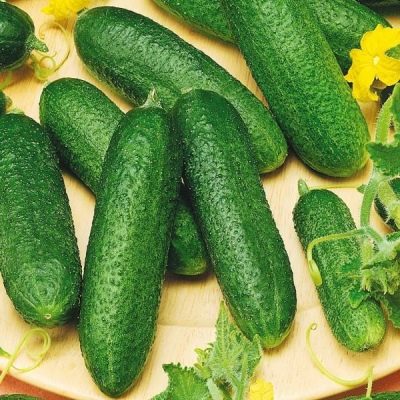
- Authors: Kudryavtsev M.G., Golovatskaya E.I.
- Year of approval: 2009
- Growth type: indeterminate
- Branching: the average
- Fruit weight, g: 63-76
- Fruit length, cm: 7,5-9,0
- Fruit color: light green with strong mottling
- Cucumber Mosaic Virus Resistance: stable
- Ripening terms: early
- Fruit shape: fusiform
Many cucumber varieties obtained by selection have strong immunity, resist ailments, attacks of harmful insects, and also adapt well to any climatic and weather conditions. At the same time, they are distinguished by high productivity. One of these hybrid varieties is the Granddaughter variety.
Breeding history
The F1 granddaughter was created by a group of domestic breeders, the leading experts were M. Kudryavtsev, E. Golovatskaya. Work began in the 2000s. The application for admission to cultivation was filed in 2005.
The culture has successfully passed the state variety test, and already in 2009 it was registered in the Federal Register. Zoned across Eastern Siberia for open field cultivation. It is also possible to cultivate in the gardens of the middle lane.
Description of the variety
The granddaughter is a 1st generation cucumber hybrid, self-pollinates (parthenocarpic), has good fruiting rates.
It can be grown both on open ground and indoors, that is, in greenhouses. The cucumber culture is early, from the moment the seeds germinate and until the first green leaves are removed, it should take about a month and a half.
Characteristics of the appearance of plants and zelents
The granddaughter is a plant with an indeterminate type of growth, cucumber vines are distinguished by unlimited height, the central stem can reach 1.4-1.6 meters and more. In late summer - early autumn, you can pinch the top. This is done when the daylight hours become shorter and the temperature has dropped.
There are not very many side shoots, so the growth of the lashes is average. Basically, ovaries are formed on the central shoot. Stems are of considerable thickness. Leaves of medium size, characteristic cucumber shape, dark emerald. Yellow flowers grow in bunches, they are mostly female, five-lobed.
Zelentsy resemble a spindle in shape, a thin peel with small tubercles is covered with white thorns, densely pubescent. The average fruit size is 7-9 cm, and the weight is 63-76 g. The color of the fruit is bright green, at the base it is lighter, with white stripes.
Purpose and taste of fruits
The granddaughter is a versatile product. The taste is excellent, cucumbers can be used for winter preparations, consumed fresh. Due to the fact that the peel is thin, cucumbers are often eaten with it and even with the seeds, which is not felt at all. The fruits have a sweetish pulp, in which there is no bitterness.
Maturation
The culture belongs to the early maturing group. From the first shoots to the beginning of fruiting, 38-42 days pass.
Yield
The average yield of the Granddaughter is 374-469 c / ha. The variety shows long-term fruiting. It is important to harvest the fruits as soon as they ripen, avoiding overgrowth, otherwise the thin skin becomes tough.
Growing regions
According to Rosreestr, the hybrid is recommended for growing in the East Siberian region. These are such republics as Buryatia, Sakha (Yakutia), Tyva, Khakassia, as well as the Irkutsk region, Krasnoyarsk and Trans-Baikal territories.
Growing and care
The beds for the Granddaughter should be chosen in the sunlit corner of the garden or vegetable garden. Water should not collect in the ground here so that the culture cannot develop root rot.The optimum acidity of the soil should be neutral or slightly alkaline (with a pH of about 6.2). It is great if the ridges are on a certain hill.
Suitable type of soil for cultivation Grandchild - sandy loam, loam. When in the country, sand prevails in the garden, it can be improved by adding humus. In a heavy type of soil, compost, sand can be added - this will improve the performance of the soil mixture, making it looser.
Sowing material Granddaughter can be planted in the ground approximately 10-12 days after the end of all frosts. The Granddaughter hybrid is early in terms of ripening, so the seeds of the culture can be planted again.
If a cool summer is observed in the region where the crop is grown, then it will be optimal to use the seedling method. In this case, the seeds must be planted somewhere in 20 days before the transfer of the grown seedlings to the place of constant growth.

In order to collect strong, tasty and beautiful cucumbers on your site, you need to make top dressing. Lack of nutrients can negatively affect the appearance of the plant and significantly reduce the yield. Fertilize cucumbers with organic fertilizers in combination with mineral fertilizers. With the right balance of these components and adherence to the fertilizing schedule, the cucumber yield will be maximum.
Disease and pest resistance
Like all hybrid varieties, Granddaughter has genetically resistant immunity to many diseases. He opposes:
- cucumber mosaic virus;
- root rot;
- powdery mildew;
- brown spot.
Only an average degree of susceptibility in culture to peronosporosis.

Despite their popularity, cucumbers are often attacked by diseases and pests. From them, cucumber plantings often die before the start of fruiting. In order to prevent this from happening, it is necessary to try to prevent ailments or get rid of them at the very beginning, having studied in detail their causes of occurrence, signs and methods of treatment.





























































































